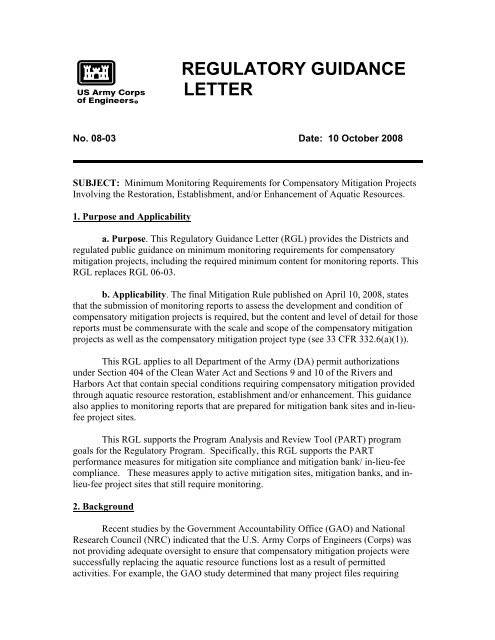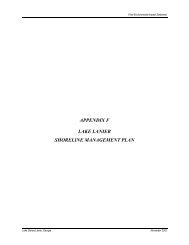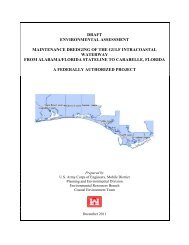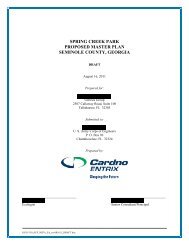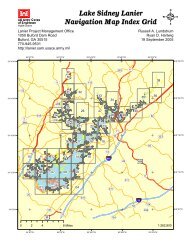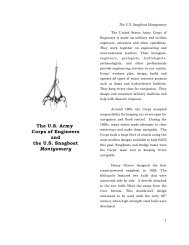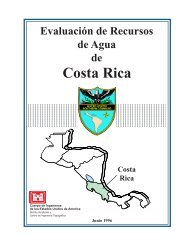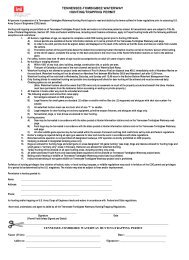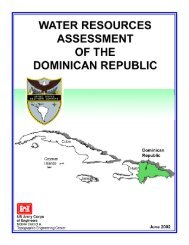REGULATORY GUIDANCE LETTER - U.S. Army
REGULATORY GUIDANCE LETTER - U.S. Army
REGULATORY GUIDANCE LETTER - U.S. Army
You also want an ePaper? Increase the reach of your titles
YUMPU automatically turns print PDFs into web optimized ePapers that Google loves.
<strong>REGULATORY</strong> <strong>GUIDANCE</strong><br />
<strong>LETTER</strong><br />
No. 08-03 Date: 10 October 2008<br />
SUBJECT: Minimum Monitoring Requirements for Compensatory Mitigation Projects<br />
Involving the Restoration, Establishment, and/or Enhancement of Aquatic Resources.<br />
1. Purpose and Applicability<br />
a. Purpose. This Regulatory Guidance Letter (RGL) provides the Districts and<br />
regulated public guidance on minimum monitoring requirements for compensatory<br />
mitigation projects, including the required minimum content for monitoring reports. This<br />
RGL replaces RGL 06-03.<br />
b. Applicability. The final Mitigation Rule published on April 10, 2008, states<br />
that the submission of monitoring reports to assess the development and condition of<br />
compensatory mitigation projects is required, but the content and level of detail for those<br />
reports must be commensurate with the scale and scope of the compensatory mitigation<br />
projects as well as the compensatory mitigation project type (see 33 CFR 332.6(a)(1)).<br />
This RGL applies to all Department of the <strong>Army</strong> (DA) permit authorizations<br />
under Section 404 of the Clean Water Act and Sections 9 and 10 of the Rivers and<br />
Harbors Act that contain special conditions requiring compensatory mitigation provided<br />
through aquatic resource restoration, establishment and/or enhancement. This guidance<br />
also applies to monitoring reports that are prepared for mitigation bank sites and in-lieufee<br />
project sites.<br />
This RGL supports the Program Analysis and Review Tool (PART) program<br />
goals for the Regulatory Program. Specifically, this RGL supports the PART<br />
performance measures for mitigation site compliance and mitigation bank/ in-lieu-fee<br />
compliance. These measures apply to active mitigation sites, mitigation banks, and inlieu-fee<br />
project sites that still require monitoring.<br />
2. Background<br />
Recent studies by the Government Accountability Office (GAO) and National<br />
Research Council (NRC) indicated that the U.S. <strong>Army</strong> Corps of Engineers (Corps) was<br />
not providing adequate oversight to ensure that compensatory mitigation projects were<br />
successfully replacing the aquatic resource functions lost as a result of permitted<br />
activities. For example, the GAO study determined that many project files requiring
mitigation lacked monitoring reports despite the fact that such reports were required as a<br />
condition of the permit. Similarly, the NRC study documented that a lack of clearly stated<br />
objectives and performance standards in the approved compensatory mitigation proposals<br />
made it difficult to ascertain whether the goal of no net loss of wetland resources was<br />
achieved.<br />
On April 10, 2008, the Corps and Environmental Protection Agency published the<br />
“Compensatory Mitigation for Losses of Aquatic Resources: Final Rule” (Mitigation<br />
Rule) which governs compensatory mitigation for activities authorized by permits issued<br />
by the Department of the <strong>Army</strong> (33 CFR Parts 325 and 332). This RGL complements and<br />
is consistent with the final Mitigation Rule.<br />
3. Discussion<br />
Inconsistent approaches to monitoring compensatory mitigation projects are one<br />
of several factors that have affected the ability of Corps project managers (PMs) to<br />
adequately assess achievement of the performance standards of Corps-approved<br />
mitigation plans. Standardized monitoring requirements will aid PMs when reviewing<br />
compensatory mitigation sites, thereby allowing the Corps to effectively assess the status<br />
and success of compensatory mitigation projects.<br />
This RGL addresses the minimum information needed for monitoring reports that<br />
are used to evaluate compensatory mitigation sites. Monitoring requirements are typically<br />
based on the performance standards for a particular compensatory mitigation project and<br />
may vary from one project to another.<br />
Monitoring reports are documents intended to provide the Corps with information<br />
to determine if a compensatory mitigation project site is successfully meeting its<br />
performance standards. Remediation and/or adaptive management used to correct<br />
deficiencies in compensatory mitigation project outcomes should be based on information<br />
provided in the monitoring reports and site inspections.<br />
4. Guidance<br />
a. Monitoring guidelines for compensatory mitigation.<br />
i. Performance Standards. Performance standards, as defined in 33 CFR 332.2,<br />
and discussed in more detail at 33 CFR 332.5, will be consistent with the objectives of<br />
the compensatory mitigation project. These standards ensure that the compensatory<br />
mitigation project is objectively evaluated to determine if it is developing into the desired<br />
resource type and providing the expected functions. The objectives, performance<br />
standards, and monitoring requirements for compensatory mitigation projects required to<br />
offset unavoidable impacts to waters of the United States must be provided as special<br />
conditions of the DA permit or specified in the approved final mitigation plan (see 33<br />
CFR 332.3(k)(2)). Performance standards may be based on functional, conditional, or<br />
other suitable assessment methods and/or criteria and may be incorporated into the<br />
2
special conditions to determine if the site is achieving the desired functional capacity.<br />
Compensatory mitigation projects offset the impacts to diverse types of aquatic resources,<br />
including riverine and estuarine habitats. Special conditions of the DA permits will<br />
clearly state performance standards specific to the type and function of the ecosystem in<br />
relation to the objectives of the compensatory mitigation project.<br />
ii. Monitoring Timeframe. The special conditions of the DA permit (or the<br />
mitigation plan as referenced in the special conditions) must specify the length of the<br />
monitoring period (see 33 CFR 332.6(a)(1)). For mitigation banks, the length of the<br />
monitoring period will be specified in either the DA permit, mitigation banking<br />
instrument, or approved mitigation plan. For in-lieu fee projects, the length of the<br />
monitoring period will be specified in either the DA permit or the approved in-lieu fee<br />
project plan.<br />
The monitoring period must be sufficient to demonstrate that the compensatory<br />
mitigation project has met performance standards, but not less than five years (see 33<br />
CFR 332.6(b)). The District determines how frequently monitoring reports are submitted,<br />
the monitoring period length, and report content. If a compensatory mitigation project has<br />
met its performance standards in less than five years, the monitoring period length can be<br />
reduced, if there are at least two consecutive monitoring reports that demonstrate that<br />
success. Permit conditions will support the specified monitoring requirement and include<br />
deadlines for monitoring report submittal. Longer monitoring timeframes are necessary<br />
for compensatory mitigation projects that take longer to develop (see 33 CFR 332.6(b)).<br />
For example, forested wetland restoration may take longer than five years to meet<br />
performance standards.<br />
Annual monitoring and reporting to the Corps is appropriate for most types of<br />
compensatory mitigation projects, though the project sponsor may have to monitor<br />
progress more often during the project’s early stages. Certain compensatory mitigation<br />
projects may require more frequent monitoring and reporting during the early stages of<br />
development to allow project managers to quickly address problems and/or concerns.<br />
Annual monitoring can resume once the project develops in accordance with the<br />
approved performance standards. In cases where monitoring is required for longer than<br />
five years, monitoring may be conducted on a less than annual timeframe (such as every<br />
other year), though yearly monitoring is recommended until the project becomes<br />
established as a successful mitigation project. In this case, off-year monitoring should<br />
include some form of screening assessment such as driving by the mitigation site,<br />
telephone conversations regarding condition of the mitigation site, etc. On-site<br />
conditions, the complexity of the approved mitigation plan, and unforeseen circumstances<br />
will ultimately determine whether the monitoring period should be extended beyond the<br />
specified monitoring time frame for a particular project. Complex and/or ecologically<br />
significant compensatory mitigation projects should have higher priority for site visits.<br />
As discussed above, the remaining monitoring requirements may be waived upon a<br />
determination that the compensatory mitigation project has achieved its performance<br />
standards. The original monitoring period may be extended upon a determination that<br />
3
performance standards have not been met or the compensatory mitigation project is not<br />
on track to meet them (e.g., high mortality rate of vegetation). Monitoring requirements<br />
may also be revised in cases where adaptive management or remediation is required.<br />
iii. Monitoring Reports. Monitoring requirements, including the frequency for<br />
providing monitoring reports to the District Commander and the Interagency Review<br />
Team (IRT), will be determined on a case-by-case basis and specified in either the DA<br />
permit, mitigation banking instrument, or approved mitigation plan. The content of the<br />
monitoring reports will be specified in the special conditions of the DA permit so that the<br />
requirements are clearly identified for the permittee or third-party mitigation sponsor. In<br />
addition, the monitoring reports should comply with the timeframes specified in the<br />
special conditions of the DA permit. Monitoring reports will not be used as a substitute<br />
for on site compliance inspections. The monitoring report will provide the PM with<br />
sufficient information on the compensatory mitigation project to assess whether it is<br />
meeting performance standards, and to determine whether a compliance visit is<br />
warranted. The party responsible for monitoring can electronically submit the monitoring<br />
reports and photos for review.<br />
Visits to mitigation sites will be documented in the administrative record and will count<br />
toward District performance goals. An enforcement action may be taken if the<br />
responsible party fails to submit complete and timely monitoring reports.<br />
b. Contents of Monitoring Reports. Monitoring reports provide the PM with a<br />
convenient mechanism for assessing the status of required compensatory mitigation<br />
projects. The PM should schedule a site visit and determine potential remedial actions if<br />
problems with the compensatory mitigation project are identified in a monitoring report.<br />
The submittal of large bulky reports that provide mostly general information<br />
should be discouraged. While often helpful as background, reiteration of the mitigation<br />
and monitoring plan content, lengthy discussions of site progress, and extensive<br />
paraphrasing of quantified data are unnecessary. Monitoring reports should be concise<br />
and effectively provide the information necessary to assess the status of the compensatory<br />
mitigation project. Reports should provide information necessary to describe the site<br />
conditions and whether the compensatory mitigation project is meeting its performance<br />
standards.<br />
Monitoring reports will include a Monitoring Report Narrative that provides an<br />
overview of site conditions and functions. This Monitoring Report Narrative should be<br />
concise and generally less than 10 pages, but may be longer for compensatory mitigation<br />
projects with complex monitoring requirements. Monitoring Report Narratives may be<br />
posted on each District’s Regulatory web site.<br />
Monitoring reports will also include appropriate supporting data to assist District<br />
Commanders and other reviewers in determining how the compensatory mitigation<br />
project is progressing towards meeting its performance standards. Such supporting data<br />
may include plans (such as as-built plans), maps, and photographs to illustrate site<br />
4
conditions, as well as the results of functional, condition, or other assessments used to<br />
provide quantitative or qualitative measures of the functions provided by the<br />
compensatory mitigation project site.<br />
c. Monitoring Report Narrative:<br />
i. Project Overview (1 page)<br />
(1) Corps Permit Number or Name of the Mitigation Bank or In-Lieu Fee Project<br />
(2) Name of party responsible for conducting the monitoring and the date(s) the<br />
inspection was conducted.<br />
(3) A brief paragraph describing the purpose of the approved project, acreage and<br />
type of aquatic resources impacted, and mitigation acreage and type of aquatic resources<br />
authorized to compensate for the aquatic impacts.<br />
(4) Written description of the location, any identifiable landmarks of the<br />
compensatory mitigation project including information to locate the site perimeter(s), and<br />
coordinates of the mitigation site (expressed as latitude, longitudes, UTMs, state plane<br />
coordinate system, etc.).<br />
(5) Dates the compensatory mitigation project commenced and/or was completed.<br />
(6) Short statement on whether the performance standards are being met.<br />
(7) Dates of any recent corrective or maintenance activities conducted since the<br />
previous report submission.<br />
(8) Specific recommendations for any additional corrective or remedial actions.<br />
ii. Requirements (1 page)<br />
List the monitoring requirements and performance standards, as specified in the approved<br />
mitigation plan, mitigation banking instrument, or special conditions of the DA permit,<br />
and evaluate whether the compensatory mitigation project site is successfully achieving<br />
the approved performance standards or trending towards success. A table is a<br />
recommended option for comparing the performance standards to the conditions and<br />
status of the developing mitigation site.<br />
iii. Summary Data (maximum of 4 pages)<br />
Summary data should be provided to substantiate the success and/or potential challenges<br />
associated with the compensatory mitigation project. Photo documentation may be<br />
provided to support the findings and recommendations referenced in the monitoring<br />
report and to assist the PM in assessing whether the compensatory mitigation project is<br />
meeting applicable performance standards for that monitoring period. Submitted photos<br />
should be formatted to print on a standard 8 ½” x 11” piece of paper, dated, and clearly<br />
labeled with the direction from which the photo was taken. The photo location points<br />
should also be identified on the appropriate maps.<br />
5
iv. Maps and Plans (maximum of3 pages)<br />
Maps should be provided to show the location of the compensatory mitigation site<br />
relative to other landscape features, habitat types, locations ofphotographic reference<br />
points, transects, sampling data points, and/or other features pertinent to the mitigation<br />
plan. In addition, the submitted maps and plans should clearly delineate the mitigation<br />
site perimeter(s), which will assist PMs in locating the mitigation area(s) during<br />
subsequent site inspections. Each map or diagram should be formatted to print on a<br />
standard 8 W' x 11" piece of paper and include a legend and the location of any photos<br />
submitted for review. As-built plans may be included.<br />
v. Conclusions (1 page)<br />
A general statement should be included that describes the conditions ofthe compensatory<br />
mitigation project. If performance standards are not being met, a brief explanation ofthe<br />
difficulties and potential remedial actions proposed by the permittee or sponsor, including<br />
a timetable, should be provided. The District Commander will ultimately determine if the<br />
mitigation site is successful for a given monitoring period.<br />
d. Completion of Compensatory Mitigation Requirements. For permitteeresponsible<br />
mitigation projects, compensatory mitigation requirements will not be<br />
considered fulfilled until the permittee has received written concurrence from the District<br />
Commander that the compensatory mitigation project has met its objectives and no<br />
additional monitoring reports are required. PMs will review the final monitoring reports<br />
to make this determination. A final field visit should be conducted to verify that on-site<br />
conditions are consistent with information documented in the monitoring reports.<br />
e. Special Condition. The following condition should be added to all DA permits<br />
that require permittee-responsible mitigation. This condition does not apply to mitigation<br />
banks or in-lieu-fee programs:<br />
Your responsibility to complete the required compensatory mitigation as set forth in<br />
Special Condition X will not be considered fulfilled until you have demonstrated<br />
compensatory mitigation project success and have received written verification ofthat<br />
success from the us. <strong>Army</strong> Corps ofEngineers.<br />
5. Duration<br />
This guidance remains in effect unless revised or rescinded.<br />
STEVEN L. STOCKTON, P.E.<br />
Director of Civil Works<br />
6


